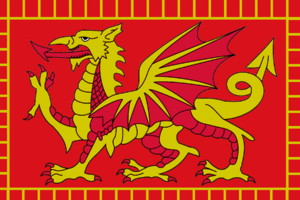East Goths: Difference between revisions
mNo edit summary Tag: 2017 source edit |
Tag: 2017 source edit |
||
| (2 intermediate revisions by the same user not shown) | |||
| Line 3: | Line 3: | ||
|image = East Goths Yonderre Flag.png | |image = East Goths Yonderre Flag.png | ||
|caption = The ''Dragon of Gothica'', a historic symbol commonly associated with East Gothic patriotism | |caption = The ''Dragon of Gothica'', a historic symbol commonly associated with East Gothic patriotism | ||
|population = ''' | |population = '''68,000,000'''<br><small>approximate</small> | ||
| regions = {{Flag|Yonderre}} | | regions = {{Flag|Yonderre}} | ||
|langs = [[East Gothic language|East Gothic]]<br>Old Gothic (historical) | |langs = [[East Gothic language|East Gothic]]<br>Old Gothic (historical) | ||
| Line 16: | Line 16: | ||
== See also == | == See also == | ||
* [[Yonderians]] | |||
* [[Gothic people]] | |||
* [[Ancient Goths]] | * [[Ancient Goths]] | ||
* [[Gothica]] | * [[Gothica]] | ||
| Line 22: | Line 24: | ||
[[Category: Ethnic groups]] | [[Category: Ethnic groups]] | ||
[[Category:Gothic people]] | |||
[[Category:Yonderians]] | |||
[[Category:Yonderre]] | [[Category:Yonderre]] | ||
[[Category:Levantia]] | [[Category:Levantia]] | ||
[[Category: Canonical Article]] | [[Category: Canonical Article]] | ||
[[Category:IXWB]] | [[Category:IXWB]] | ||
Latest revision as of 21:08, 7 August 2023
 The Dragon of Gothica, a historic symbol commonly associated with East Gothic patriotism | |
| Total population | |
|---|---|
| 68,000,000 approximate | |
| Regions with significant populations | |
| Languages | |
| East Gothic Old Gothic (historical) | |
| Religion | |
| Levantine Catholicism East Gothic faith (historical) | |
| Related ethnic groups | |
| Gothic people |
The East Goths are an ethnic and cultural group native to Yonderre, today considered part of (and thus largely replaced by) the Yonderian ethno-cultural group.
East Gothic culture, as distinct from its West Gothic neighbours, evolved in the later medieval period. Following the Conquest of Joanusterra the East Gothic culture further diversified in the early modern period, owing largely to Bergendii cultural influence. During the Yonderian Golden Age of the nineteenth century, the concepts of East Gothic and Bergendii cultural and ethnic groupings became muddled as a common Yonderian ethno-cultural group emerged, founded on principles formed through historical and cultural connections rather than based on racial heritage.
Some East Goths maintain their separateness from the common Yonderian group, a notable example being those who adhere to the ethno-nationalist Gothic People's Party.